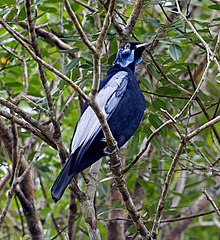| Bare-necked fruitcrow | |
|---|---|

| |
| Drawing by John Keulemans 1901 | |

| |
| Conservation status | |
 Least Concern (IUCN 3.1) | |
| Scientific classification | |
| Domain: | Eukaryota |
| Kingdom: | Animalia |
| Phylum: | Chordata |
| Class: | Aves |
| Order: | Passeriformes |
| Family: | Cotingidae |
| Genus: | Gymnoderus E. Geoffroy Saint-Hilaire, 1809 |
| Species: | G. foetidus |
| Binomial name | |
| Gymnoderus foetidus (Linnaeus, 1758) | |

| |
| Synonyms | |
| |
The bare-necked fruitcrow (Gymnoderus foetidus) is a species of bird in the family Cotingidae. It is the only member of the genus Gymnoderus. It is found in the Amazon Rainforest, especially near rivers. It is relatively common, but generally rarer and more local north of the Amazon River. Both sexes are overall mainly blackish, but the male has distinctive, large greyish-blue facial- and neck-wattles and greyish-white wings, which flash conspicuously in flight.
Taxonomy
The bare-necked fruitcrow was formally described in 1758 by the Swedish naturalist Carl Linnaeus in the tenth edition of his Systema Naturae under the binomial name Gracula foetida. Linnaeus specified the type locality as America but in 1902 the locality was restricted to Surinam. The bare-necked fruitcrow is now the only species placed in the genus Gymnoderus that was introduced in 1809 by the French naturalist Étienne Geoffroy Saint-Hilaire. The genus name combines the Ancient Greek gumnos meaning "bare" or "naken" with dera meaning "neck" or "throat". The specific epithet foetidus is Latin meaning "stinking". The species is monotypic: no subspecies are recognised.
A large molecular phylogenetic study of the suboscines published in 2020 found that the bare-necked fruitcrow was sister to the black-faced cotinga (Conioptilon mcilhennyi).
Conservation status
Population numbers appear to be decreasing, but because it is less than a 30% decline over ten years or three generations, the species is not on the Vulnerable list.
References
- ^ BirdLife International (2016). "Gymnoderus foetidus". IUCN Red List of Threatened Species. 2016: e.T22700916A93804304. doi:10.2305/IUCN.UK.2016-3.RLTS.T22700916A93804304.en. Retrieved 13 November 2021.
- Linnaeus, Carl (1758). Systema Naturae per regna tria naturae, secundum classes, ordines, genera, species, cum characteribus, differentiis, synonymis, locis (in Latin). Vol. 1 (10th ed.). Holmiae (Stockholm): Laurentii Salvii. pp. 108–109.
- ^ Traylor, Melvin A. Jr, ed. (1979). Check-List of Birds of the World. Vol. 8. Cambridge, Massachusetts: Museum of Comparative Zoology. p. 301.
- Berlepsch, Hans von; Hartert, Ernst (1902). "On the birds of the Orinoco region". Novitates Zoologicae. 9: 1–135 .
- Geoffroy Saint-Hilaire, Étienne (1809). "D'une nouvelle espèce d'oiseau, voisine du Corvus nudus et du Corvus calvus, et établissement de ces trois espèces en autant de genres, sous les noms de Cephalopterus, Gymnoderus et Gymnocephalus". Annales Muséum National d'Histoire Naturelle (in French). 13: 235–238 .
- ^ Gill, Frank; Donsker, David; Rasmussen, Pamela, eds. (December 2023). "Cotingas, manakins, tityras, becards". IOC World Bird List Version 14.1. International Ornithologists' Union. Retrieved 16 June 2024.
- Jobling, James A. (2010). The Helm Dictionary of Scientific Bird Names. London: Christopher Helm. pp. 182, 162. ISBN 978-1-4081-2501-4.
- Harvey, M.G.; Bravo, G.A.; Claramunt, S.; Cuervo, A.M.; Derryberry, G.E.; Battilana, J.; Seeholzer, G.F.; McKay, J.S.; O’Meara, B.C.; Faircloth, B.C.; Edwards, S.V.; Pérez-Emán, J.; Moyle, R.G.; Sheldon, F.H.; Aleixo, A.; Smith, B.T.; Chesser, R.T.; Silveira, L.F.; Cracraft, J.; Brumfield, R.T.; Derryberry, E.P. (2020). "The evolution of a tropical biodiversity hotspot". Science. 370 (6522): 1343–1348. Bibcode:2020Sci...370.1343H. doi:10.1126/science.aaz6970. hdl:10138/329703. PMID 33303617. S2CID 228084618. A high resolution version of the phylogenetic tree in Figure 1 is available from the first author's website here.
| Taxon identifiers | |
|---|---|
| Gymnoderus foetidus |
|
| Gracula foetida | |
This Cotingidae-related article is a stub. You can help Misplaced Pages by expanding it. |
